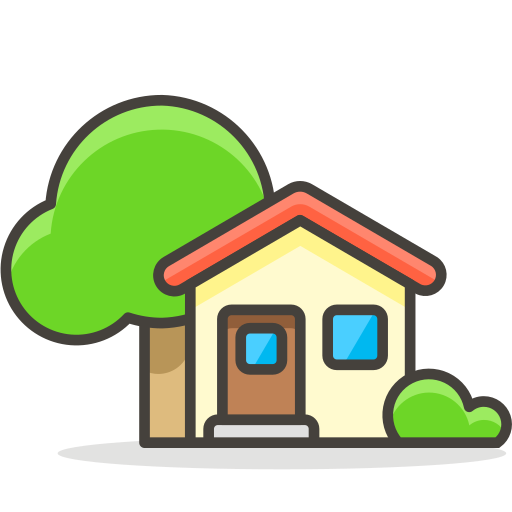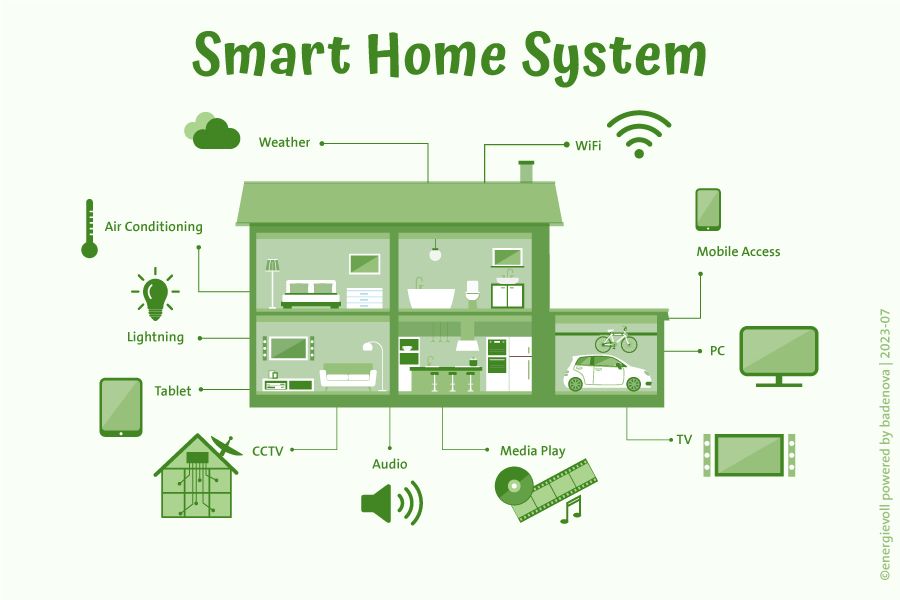The Smart Home Revolution — Why the Future Arrived So Quietly
Welcome to the Future, Already in Progress
It happened even though you were unaware of it.
The thermostat that waits for you.
When a stranger comes to your door, the camera alerts you.
The refrigerator that alerts you when milk is running low.
Without any headlines or fireworks, we’ve crossed a threshold.
The tech elite and the wealthy are no longer the only ones with smart homes.
They have completely changed the way we live, secure, maintain, and interact with our homes. They have become so ingrained in daily life that it is difficult to identify them for what they are.
And by 2025, that evolution is quickening.
From Luxury to Necessity: The Smart Home Shift
At one point, “smart homes” seemed like something you might see on the stage of a Las Vegas tech expo: aloof, streamlined, and unreachable.
According to Statista (2025), more than 68% of American homes currently have at least one smart home appliance, such as connected lighting, security cameras, or voice assistants. Furthermore, more than 40% intend to add two or more devices in the upcoming year.
This is no longer about technology.
It has to do with empowerment.
It has to do with control.
It’s about finding tranquility in a constantly changing world.
What Exactly Makes a Home “Smart” in 2025?
Since the modern smart home has developed far beyond a Wi-Fi plug or smart speaker, let’s define it.
💡 Without requiring continual human input, a 2025 smart home is a responsive, networked ecosystem of gadgets, sensors, systems, and automations that enhance comfort, safety, efficiency, and quality of life.
The most influential smart home systems available today include:
| Category | Examples of Smart Tech |
|---|---|
| Security | Smart locks, motion cameras, doorbell video, alarm systems with AI intrusion detection |
| Energy | Smart thermostats, lighting systems, solar panel optimization, EV charger sync |
| Comfort | Voice assistants, HVAC automation, intelligent blinds, mood lighting scenes |
| Appliances | Smart fridges, washers/dryers, ovens, robot vacuums, leak detectors |
| Access & Control | Voice, app, facial recognition, geofencing, scheduling, remote access |
And what binds it all? Connectivity + AI.
The smart homes of 2025 will be learning homes at last, adjusting to your preferences, saving you time, and safeguarding your loved ones even when you’re not there or asleep.
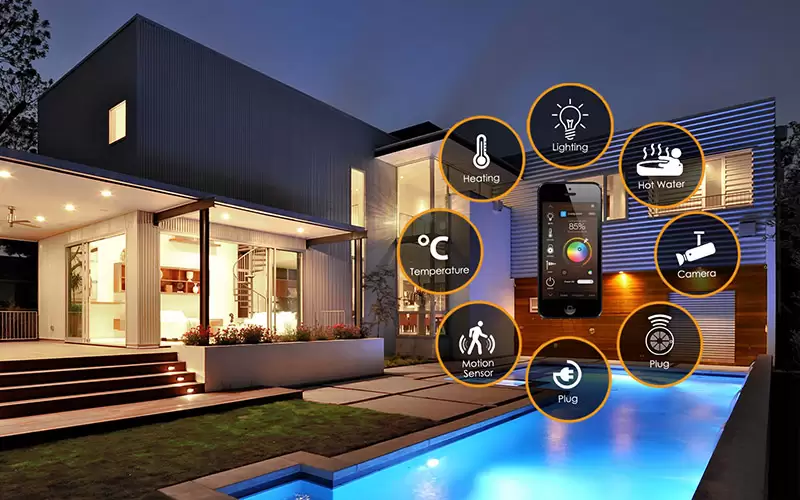
What-Is-the-Difference-Between-a-Smart-Home-and-Home-Automation-2
Why This Evolution Was Inevitable
The switch from conventional to smart homes wasn’t sudden. Five major trends served as its foundation:
- The Shift to Home-Centric Living Caused by the Pandemic
Learning, entertaining, working, and exercising all took place indoors. More people than ever before made an investment in their spaces. - Technology Advances at an Exponential Rate
Real-time decision-making without the need for large servers became feasible as AI and edge computing made their way into consumer-level devices. - Significant Price Drops
In 2025, $150 can be used more effectively than $2,000 in 2015. - Awareness of Sustainability and Efficiency
Demand for smart lighting, energy management systems, and thermostats increased as a result of rising energy prices and environmental consciousness. - Anxiety about Crime and Safety
Families are finding that smart security systems are a must in light of the constant news cycle and growing urban uncertainty.
How AI Took Over Without Us Realizing
AI is the nervous system of the body, if the smart home is the body.
A neural network anticipates your schedule and powers your smooth morning routine.
A predictive algorithm optimizes comfort and utility costs by lowering the thermostat on its own.
Computer vision detects abnormalities in movement or sound, which is the mechanism behind the baby monitor alert.
By 2025, smart homes will be proactive rather than reactive.
Real-World Example: When traveling, a family in San Diego used to manually lock up and keep an eye on their property. With the help of Ring, SimpliSafe, and IFTTT automations, they can now stream live video, receive movement alerts, and even use randomized lighting to make it appear like someone’s house from the beach.
The Social Psychology of the Smart Home
Here’s a surprising fact:
People with smart homes report feeling “more in control” and “less anxious” about their surroundings — especially parents and elderly homeowners.
Smart home tech is tapping into our most basic human needs:
-
Security: Are my family and belongings safe?
-
Convenience: Can my home help me — without me asking?
-
Belonging: Does this space understand me?
It’s not just tech. It’s emotional architecture.
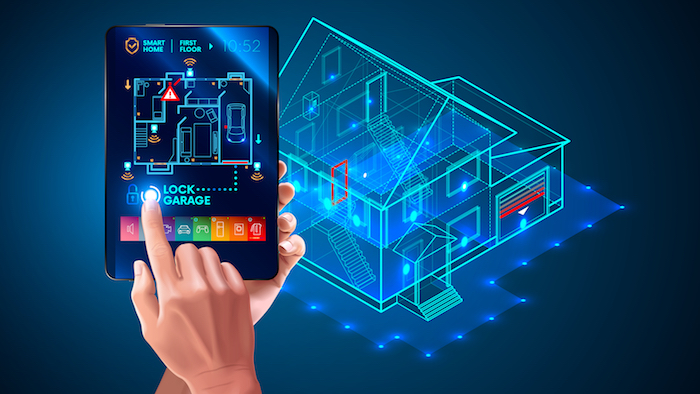
IOT. Smart home system application interface. 3d house plan x-ray. Hand touching on tablet screen. Control locks doors and windows over internet of things with tablet application. Security Home System
The Great Equalizer: Accessibility for All
2025 has also brought dramatic accessibility gains.
Thanks to voice control, remote access, and automation, smart homes empower:
-
Seniors to age in place safely
-
People with disabilities to live independently
-
Single parents to manage chaos with less mental load
🟢 According to the AARP Smart Home Report (2025), 79% of adults aged 60+ say they feel safer and more confident in a smart-enabled home.
This isn’t elitist tech anymore. It’s life-changing.
Privacy Concerns: The Elephant in the Living Room
It’s not all sunshine and automation, of course.
There are legitimate concerns about privacy that accompany smart homes.
Numerous pieces of information are gathered by smart devices, including your voice, routines, habits, where you go, and what you say.
But 2025 offers new protections, including:
-
On-device AI (processing without sending data to the cloud)
-
Encrypted local storage for camera systems
-
Increased regulation and consumer rights, especially in the EU and U.S. under new privacy legislation
Consumers have more control than ever before — and smart manufacturers are finally listening.
Learn more about smart home privacy laws → (Electronic Frontier Foundation)
Why You Can’t Afford to Ignore This Trend
Let’s be real: in 2025, ignoring smart home upgrades is like ignoring the internet in 2003.
This is the infrastructure of modern living — and whether you’re a homeowner, renter, designer, real estate investor, or builder, adapting isn’t optional.
Here’s what’s at stake:
| If You Embrace Smart Tech | If You Ignore It |
|---|---|
| Enhanced safety & convenience | Increased vulnerability |
| Higher home resale value | Diminishing market appeal |
| Energy savings & automation | Rising energy bills & manual labor |
| Appeal to modern tenants | Losing competitive edge in real estate |
| Better lifestyle & control | Fragmented, outdated experience |
Smart Homes Are No Longer a Luxury — They’re the New Normal
Part 2: The Building Blocks of a Smart Home in 2025
It’s becoming more and more obvious as we delve deeper into the world of smart homes that these futuristic homes are about a total rethinking of how we live, interact, and secure our spaces—not just about gadgets. The fundamental components of a truly smart home in 2025 will be discussed in this second section, along with integrated systems, sustainability, necessary gadgets, and the expanding application of AI in daily life.
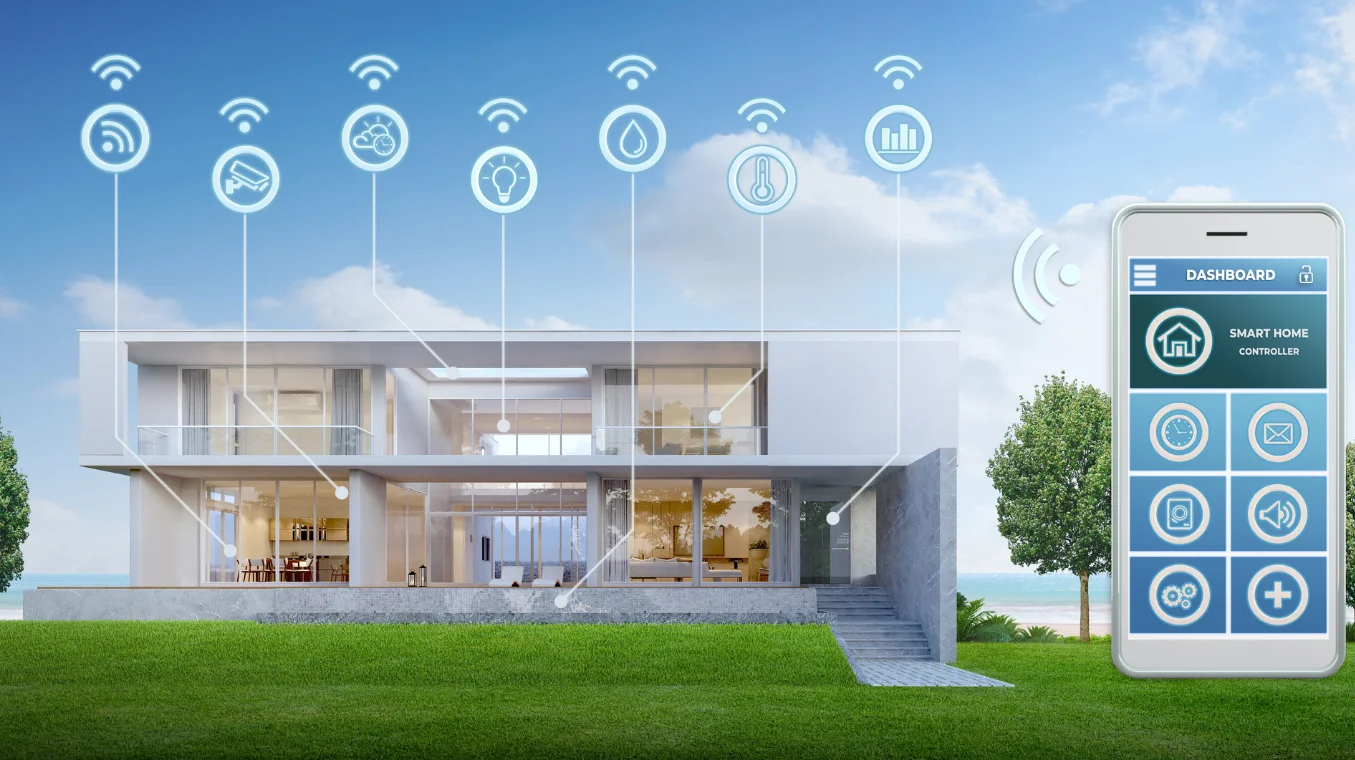
Smart-Security-Systems
Essential Smart Devices in Every Home
Let’s start with the essential components—the gadgets that make up a smart home’s framework. These devices are becoming as commonplace as light switches or thermostats; they are no longer optional.
1. Smart Thermostats
These gadgets have changed a lot. By 2025, they actively learn from your behavior rather than merely permitting remote control. Nowadays, companies like Nest and Ecobee use machine learning to adjust in real time to variations in the weather, energy prices, and your daily schedule, guaranteeing optimal comfort and minimizing waste.
2. Voice-Activated Hubs and Assistants
Apple’s Siri, Google Assistant, and Amazon Alexa have progressed from being novelties to everyday essentials. In 2025, what’s new? greater awareness of context. These days, these assistants can predict your needs, recommend adjustments to your surroundings, and even work in unison with other gadgets to ensure smooth operation.
3. Smart Lighting Systems
Simple on/off commands are a thing of the past. Modern smart lights adapt to occupancy, energy prices, circadian rhythms, and even your mood. AI-powered ambiance controllers from Philips Hue, LIFX, and Nanoleaf adjust light levels for relaxation, sleep, and productivity.
4. Security Devices
Face recognition doorbells, motion sensors, smart cameras, and AI threat detection software are now necessities. Not only do these gadgets warn you, but they also assess dangers, distinguish between people and animals, and even call emergency services on their own.
Home Integration: The Magic of Ecosystems
A smart home is only as intelligent as its ability to connect and coordinate. 2025 is the era of the home ecosystem.
Unified Platforms
Interoperability between Samsung SmartThings, Google Home, and Apple HomeKit has advanced significantly. Devices from various brands now integrate more seamlessly than ever thanks to the development of Matter, a universal connectivity standard.
Cross-Device Automation
Do you want Spotify to start playing lo-fi music, your blinds to close, and your air conditioner to turn on when you get home from work? Completed. 2025 smart homes provide customized automation without requiring any effort by executing scenes based on geofencing, biometric input, or the time of day.
Health & Wellness Integration
The number of homes that focus on health is increasing. Smart mirrors assess your skin condition and hydration levels, track your sleep patterns, and even identify early indicators of stress. Humidity sensors also make real-time adjustments to the air quality.
Sustainable Living Through Smart Technology
Sustainability isn’t a bonus anymore—it’s a mandate. Smart homes are at the forefront of environmental stewardship.
Energy Monitoring & Optimization
Homeowners can monitor usage minute by minute with the aid of real-time energy dashboards. Then, AI-powered systems automatically recommend or alter things to lessen carbon emissions. Consider shutting off unused electronics, shifting power to batteries during periods of high demand, or only doing laundry when solar energy is plentiful.
Smart Water Systems
Leak detection sensors, smart irrigation based on weather patterns, and even AI-controlled showers now help homes save thousands of gallons of water annually.
Waste Management Tech
In order to reduce food waste, kitchens now have smart composters, recycling sorters, and food inventory trackers that can recommend recipes based on what’s in your refrigerator or notify you before items expire.
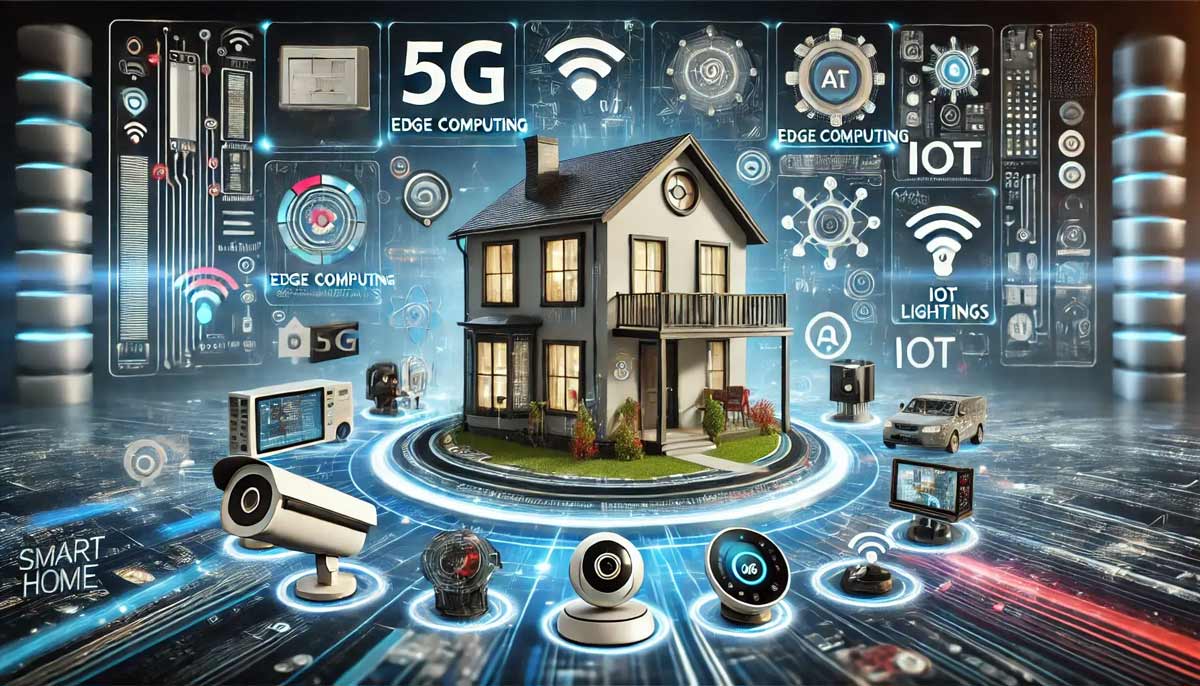
Market-Research-Growth-and-Trends-in-Smart-Home-Automation-DM-WebSoft-LLP-(1)
The Rise of AI in Home Living
AI is no longer hidden in the background. In 2025, it’s actively shaping experiences.
Predictive AI
Based on your schedule, routines, and even biometric input, your house can predict your needs. Did you forget to take your prescription? You are reminded by the smart mirror. Are you under stress? Calm tones take over the ambient lighting.
Learning-Based Enhancements
The longer you live in a home, the smarter it becomes. AI now dynamically changes lighting, temperature, and even music preferences based on your changing lifestyle.
Security & Privacy AI
Your house can identify who belongs and who doesn’t thanks to facial recognition and behavior analysis. Additionally, it guarantees that all of your data is encrypted and kept locally or in multi-layered authentication-protected clouds.
Comparison Table: Old Homes vs. Smart Homes in 2025
| Feature | Traditional Home | Smart Home 2025 |
|---|---|---|
| Lighting | Manual switches | AI-powered, mood-adaptive |
| Thermostat | Manual, analog | Machine learning with geo-fencing |
| Security | Basic lock & key | Facial recognition & threat detection |
| Appliances | Standalone | Networked & voice-controlled |
| Energy Use Tracking | Monthly bills | Real-time dashboards & automation |
| Health Monitoring | Nonexistent | Biometric-integrated devices |
| Water Usage | Manual irrigation | AI-optimized & weather-adjusted |
In Summary
The question of whether smart homes are the future or not is no longer relevant; they are already here. How soon we can democratize this technology so that everyone can use it is the true question. We’ll examine the financial implications, possible obstacles, and how to budget your way into smart living in the next and last section of this post.
The Smart Home Ecosystem: Integration, Intelligence, and Immediacy
Total Integration: From Gadgets to a Cohesive Experience
The days of defining a smart home with a voice assistant or a smart lightbulb are long gone. True smart living in 2025 will be about integration—a unified system in which HVAC, lighting, security, entertainment, and even grocery ordering operate in tandem rather than independently. The “central nervous system” of contemporary homes is being replaced by systems like Amazon Alexa, Samsung SmartThings, and Apple HomeKit, which guarantee smooth device coordination.
Your doorbell camera connects to your smart lock, your thermostat modifies itself according to your calendar, and your refrigerator speaks to your phone. The outcome? a simple, intuitive way of living where you don’t have to do anything unless you want to.
Backlink: How Matter is Unifying the Smart Home — The Verge
AI at the Helm: Predictive, Personalized, Perfected
The term “artificial intelligence” is no longer trendy. It is the main factor enabling smart homes to adjust to your preferred way of life. AI learns, not just automates. Your house can now:
- Identify your voice and set it apart from others.
- Recognize your routine and make proactive temperature or lighting adjustments.
- Give advice on energy optimization in real time.
- Make wellness activity recommendations based on your mood and sleep habits.
A truly unique living space is produced by this personalization. It also knows you better than you do in a lot of ways.
Your doorbell camera connects to your smart lock, your thermostat modifies itself according to your calendar, and your refrigerator speaks to your phone. The outcome? a simple, intuitive way of living where you don’t have to do anything unless you want to.
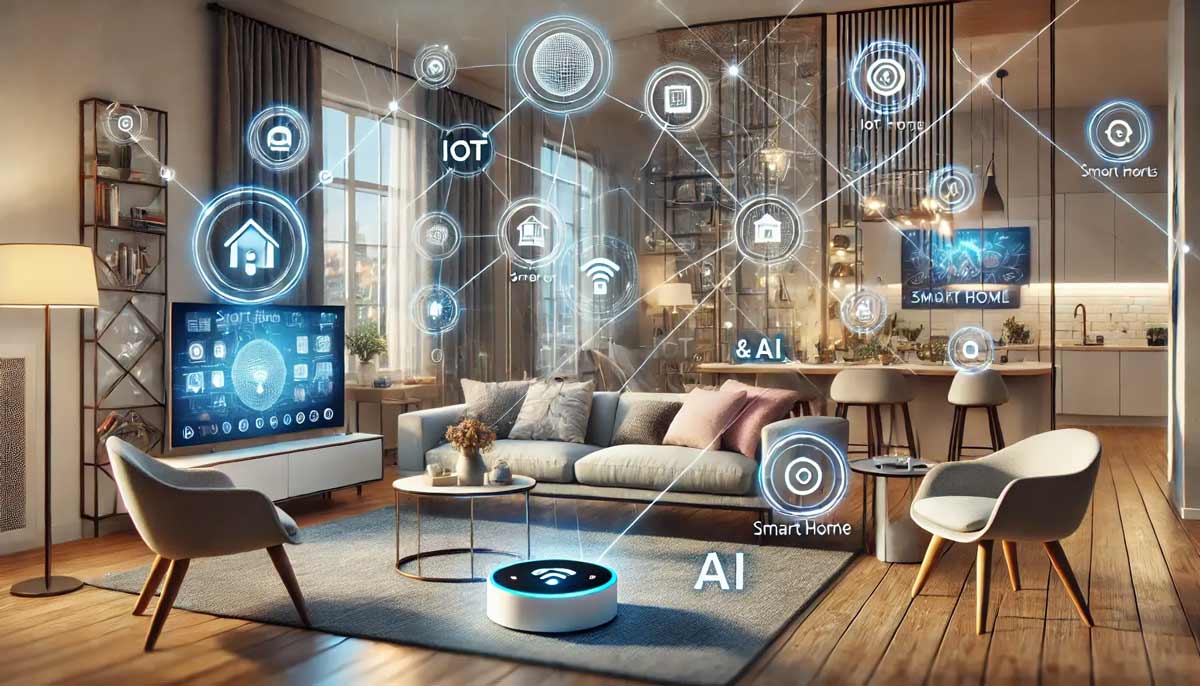
Introduction-The-Intersection-of-IoT-and-AI-Enhancing-Smart-Home-Experiences-DM-WebSoft-LLP
Green Living: Smart Homes and Sustainability
The environmental impact of smart homes is one of their less well-known but equally significant advantages. Energy management is no longer done by hand. Smart meters, automated blinds, and grid-integrated appliances help your home save the environment in addition to saving you money.
Some statistics from 2024 and 2025:
| Feature | Energy Savings (Avg. Annually) | Impact Level |
|---|---|---|
| Smart Thermostats | 10-15% | High |
| Smart Lighting Systems | 8-12% | Medium |
| AI-optimized HVAC | 20-25% | Very High |
| Solar with Smart Inverters | 30-40% (on electricity bill) | Extreme |
Backlink: Energy Star Smart Home Solutions 2025
What’s Driving This Mass Adoption in 2025?
Smart homes are no longer a tech-savvy trend—they’re being driven by necessity. Let’s break down the key reasons behind the shift from luxury to norm:
1. Affordability
Devices are now mass-produced, and starter kits for a basic smart home can cost less than $150.
2. Post-Pandemic Behavior
Remote work, online health, and digital security demands have changed how people see the home—it must now be responsive, secure, and efficient.
3. Real Estate Value
Smart homes sell faster and for more. Homebuyers now see smart features as expected, not optional.
Backlink: Zillow Research on Smart Homes Value
Challenges on the Horizon
Even as smart homes become the standard, we’re not without issues. Key challenges include:
-
Privacy Concerns: Who owns the data your home collects?
-
Cybersecurity Risks: Is your smart lock hackable?
-
Tech Fragmentation: Not all devices “talk” to each other, though Matter is helping.
FAQs About Smart Homes in 2025
1. Are 2025 smart homes safe?
Yes, provided that you use trusted platforms, update firmware frequently, and connect to encrypted networks. But alertness is essential.
2. Is it possible for smart homes to function offline?
While many devices, particularly lights and thermostats, can operate partially offline, cloud services like voice assistants need internet access.
3. How much does it cost to convert an old house into a smart home?
No longer. Retrofitting is simple and inexpensive with wireless, modular systems. These days, a simple smart home can be constructed for less than $500.
4. Do smart homes raise the value of real estate?
Of course. Several real estate surveys indicate that homes with smart features sell more quickly and for more money.
5. Do eco-friendly smart homes exist?
Indeed. Automation and intelligent energy use drastically cut waste and your carbon footprint.
Conclusion: The Home Has Evolved—Have You?
“Should I get a smart home?” isn’t the question in 2025. “What’s holding me back?” is the question.
Smart homes are now essential infrastructure rather than glitzy tech toys. They help us stay healthy, work from home, maximize energy, safeguard our families, and even age well. Whether you’re a retiree, a family with children, or a millennial, smart living is now the norm.
The best part is that it isn’t costly or complicated.
Today is the day to begin if you haven’t already.
